
Poultry are domesticated birds kept by humans for the purpose of harvesting animal products such as meat, eggs or feathers. The practice of raising poultry is known as poultry farming. These birds are most typically members of the superorder Galloanserae (fowl), especially the order Galliformes. The term also includes waterfowls of the family Anatidae but does not include wild birds hunted for food known as game or quarry.

The American Game is an American breed of game fowl, chickens bred specifically for cockfighting. It has many color varieties, and may also be kept for ornament.

The Cochin is a breed of large domestic chicken. It derives from large feather-legged chickens brought from China to Europe and North America in the 1840s and 1850s. It is reared principally for exhibition. It was formerly known as Cochin-China.

The Malay Game is a breed of game chicken. It is among the tallest breeds of chicken, and may stand over 90 cm high.

A domestic goose is a goose that humans have domesticated and kept for their meat, eggs, or down feathers. Domestic geese have been derived through selective breeding from the wild greylag goose and swan goose.
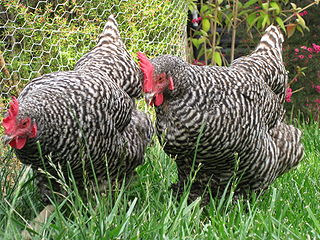
The Plymouth Rock is an American breed of domestic chicken. It was first seen in Massachusetts in the nineteenth century and for much of the early twentieth century was the most widely kept chicken breed in the United States. It is a dual-purpose bird, raised both for its meat and for its brown eggs. It is resistant to cold, easy to manage, and a good sitter.

The Dominique is an American breed of chicken, characterized by black-and-white barred plumage and a rose comb. It is considered to be the oldest American chicken breed, and is thought to derive from birds brought to America by colonists from southern England. It was well known by about 1750, and by the mid-nineteenth century was widely distributed in the eastern United States. It is a dual-purpose breed, but is kept principally for its brown eggs. It became an endangered breed in the twentieth century, but numbers have since recovered.
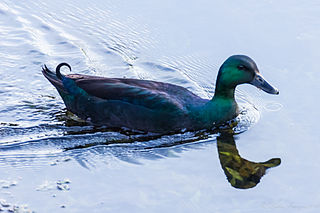
The Cayuga is an American breed of domestic duck. It was introduced to the Finger Lakes region of New York State in about 1840, and is named for the Cayuga people of that area. Until the last years of the nineteenth century it was the principal duck reared for meat in the United States. In the twenty-first century it is kept mainly for ornament. The plumage is black with iridescent beetle-green lights.
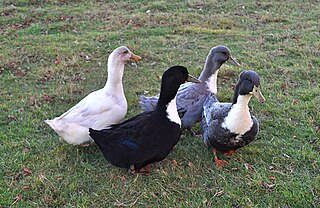
The Swedish Blue or Blue Swedish is a Swedish breed of domestic duck. It originated in the former dominion of Swedish Pomerania – now in north-west Poland and north-east Germany – and is documented there from 1835. It is closely similar to the Pomeranian Duck from the same general area, differing mainly in its white primary feathers.
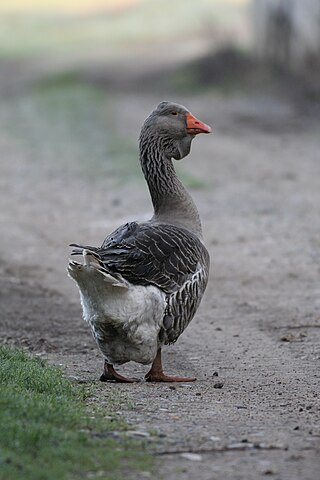
The Toulouse is a French breed of large domestic goose, originally from the area of Toulouse in south-western France. Two types are recognised: a heavy industrial type with dewlaps, the French: Oie de Toulouse à bavette; and a slightly lighter agricultural type without dewlaps, the French: Oie de Toulouse sans bavette. Both types are large, with weights of up to 9 kg. Birds bred in the United Kingdom and United States exclusively for showing may be still larger, and have a somewhat different conformation.

The Emden or Embden is a German breed of domestic goose. It is named for the town of Emden in north-westernmost Germany.

The New Hampshire Red or New Hampshire is an American breed of chicken. It was developed in the early twentieth century in the state of New Hampshire by selective breeding of Rhode Island Red stock; no other breed was involved. It is fast-growing, early-maturing, quick-feathering, and yields a meaty carcass. Mature birds are a light or medium red in color; they may fade in sunlight.
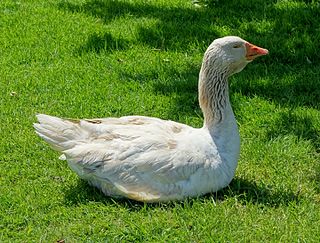
The American Buff is an American breed of domestic goose. It was accepted by the American Poultry Association in 1947. It is named for its single plumage variety, which is a pale buff or apricot-fawn in color.

The African or African Goose is a breed of domestic goose. It is one of two domestic breeds that derive from the wild species Anser cygnoides, the other being the Chinese; all other domestic geese derive from Anser anser. Despite the name, it is not from Africa but is of Asiatic origin. It is a large bird, among the heaviest of all goose breeds.
The Nankin Bantam or Nankin is a British bantam breed of chicken. It is a true bantam, a naturally small breed with no large counterpart from which it was miniaturised. It is of South-east Asian origin, and is among the oldest bantam breeds. It is a yellowish buff colour, and the name is thought to derive from the colour of nankeen cotton from China.

The Silver Appleyard is a British breed of domestic duck. It was bred in the first half of the twentieth century by Reginald Appleyard, with the aim of creating a dual-purpose breed that would provide both a good quantity of meat and plenty of eggs.

The Asil or Aseel is an Indian breed or group of breeds of game chicken. It is distributed in much of India, particularly in the states of Tamil Nadu, Andhra Pradesh, Chhattisgarh and Odisha; it has been exported to several other countries. Similar fowl are found throughout much of Southeast Asia.
The Vištinės or Vishtines is a Lithuanian breed of domestic goose. It was developed by selective breeding of traditional Lithuanian geese, with some later influence from the East Prussian, Emden and Pomeranian breeds.
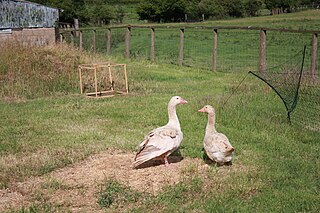
The Brecon Buff Goose is a breed of domestic goose originating in Wales.



















